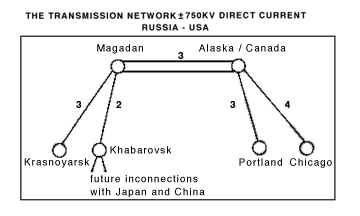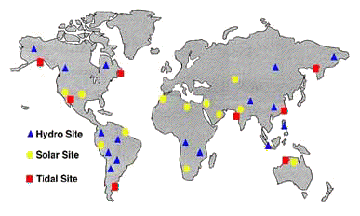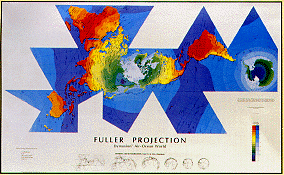
WINTER-SPRING-1992
| INSIDE > |
Power Enginers state that abundant renewable
energy exists today. Available with present
technology
|
e must see the problem as a whole. We must understand
and explain to all other men on our planet that
the interconnection between power systems of
different countries is one of the important
tasks for all humanity."
Victor Yershevich, Head of Russian
Delegation, Director of Science, Energoset Project
|
Table of Contents
Introduction
Regional Focus
The Technology of High Voltage
Systems
Potential Markets and
Uses
Sociopolitical
Implications
Environmental
Implications
Economic Costs
Economic Benefits
Potential Sources
of Financing and Additional Research Requirements
Conclusion and
Recommendation
Dear GENI Friend;
Support for the GENI proposal is growing
daily around the world. Recent meetings in
Russia, Alaska, and New York have strongly
corroborated our work.
 In January, Russian specialists joined Alaskan
engineers to explore the renewable energy
potential of the northern region and the transmission
of power to demand centers between the two
nations, as well as to China, North and South
Korea, Japan and Canada. This meeting was
the first step in a long process. The Summary
of Discussions is included in this edition.
In January, Russian specialists joined Alaskan
engineers to explore the renewable energy
potential of the northern region and the transmission
of power to demand centers between the two
nations, as well as to China, North and South
Korea, Japan and Canada. This meeting was
the first step in a long process. The Summary
of Discussions is included in this edition.
Later that month, the Institute of
Electrical and Electronic Engineers-Power
Engineering Society (IEEE/PES)
hosted a panel session to examine large-scale,
remote renewable energy around the world that
could be delivered reliably, as well as cost
competitively. All agreed the expansion of
inter-regional electrical networks would cause
a reduction in fossil fuel use and subsequent
pollution. Excerpts from that discussion are
also inside.
After the setbacks caused by the Cold
War and oil politics in the 70,s and 80,s,
GENI now has strong interest from the energy
and environmental divisions of the United
Nations. Member states are viewing GENI as
the project that promotes development, reduces
pollution, and enhances international cooperation.
The United Nations is cooperating
with us to produce a World
Conference on Electrical Interconnections
in Sydney, Australia in November. We plan
a much deeper, quantitative analysis than
was done at the Winnipeg Workshop last year.
This follows the upcoming UN
Earth Summit this June in Brazil. Our delegation
will be speaking with representatives from
all participating nations.
We need your help now. As the Russians
and American struggle to convert military
equipment and jobs to civilian use, we assert
that the connecting of international and inter-regional
electric energy networks will inspire the
engineers, create new jobs, and provide a
vision for the New World Order. We seek you
help in making this the priority project in
all countries this year.
In Partnership,
Peter Meisen
Executive Director
|
GENI DIRECTORS AND OFFICERS:
Len Bateman, Will Gannett, Robert Kiyosaki,
Wyn Knapp, Peter Meisen, David Steven, Kim
Watkins
GENI ADVISORS:
Raghbir Basi, Brian Bieler, Milton Byrd, David
Cline, Mark Victor Hansen, Terry Lipman, Karen
Morgan, Robert Muller, Glenn Olds, Malcolm Roberts,
Marshall Thurber
Newsletter
produced by KING & COMPANY, San diego,
California, U.S.A.
|
The Potential of an
Electrical Interconnection Between Russia and
North America
Held in Anchorage, Alaska, USA January 15-17,
1992
Hosted by: The Alaska Department of Commerce
and Economic Development,
The Alaska Energy Authority,
The Alaska Rural Electric Cooperative Association,
and Global Energy Network Institute
INTRODUCTION
The
objec-
tive of
this work-
shop was to
explore a proposal
to provide low-cost
electrical power to North
America and Russia by link-
ing the two continents with a
high voltage power transmission
line. Thousands of years ago, Asia
and North America were linked by the
Bering Land Bridge, and people walked
between what are now two continents. Until
recently, the United States and Russian borders
were closed except for an occasional excursion
by
local Eskimos and military observers. The thawing
of
the Cold War caused a shift in the superpower
relationship,
from polarization to cooperation and the pursuit
of mutual benefits.
Energy specialists from both countries came together
in Anchorage,
Alaska for a workshop to explore the potential
for transmitting electricity
between the continents.
Delegates
|
Gregory N. Aleksnadrov, Leningrad Tech.
Univ.
|
Afzal Khan, Alaska Energy Authority
|
|
Moe Aslam, Municipal Light and Power
|
Peter Meisen, GENI
|
|
Raghbir S. Basi, Alaska Pacific Univ.
|
Brent Petrie, Alaska Energy Authority
|
|
Lev S. Belyaev, Siberian Energy Institute
|
Robert Retherford, P.E. Consultant
|
|
Bob Bulmer, Alaska Dept. of Commerce
|
Nikolai Voropai, Siberian Energy Institute
|
|
Vladilen Fotin, Electrotechnical Institute
|
Michael Wolfe, Int'l Energy Systems Consultant
|
|
Vladimir Gatanov, HVDC Power Transmission
Research Inst.
|
Norio Yamamoto, Global Infrastructure
Fund Japan (Attended 1/15
only)
|
|
Dora Gropp, Chugach Electric Assoc.
|
Victor Yershevich, Energoset Project
|
Regional Focus
Alaska and the Russian Far East are essential for
an intercontinental link. They share a common geography
with a climate of extreme conditions. Permafrost is
common to both regions and a challenge for system
planners in northern latitudes. Both have enormous
natural resources spanning vest territories. Yet the
population density and energy demand within these
regions remain small.
The existing transmission systems in the Russian
Far East and Alaska have been developed to connect
only their respective isolated loads. The Kamchatka
Peninsula, Magadan and Yakutia regions, and northern
Khabarovsk region in Russia operate independently.
In Alaska, the only significant interconnect links
one narrow strip of communities called the Railbelt.
Voltage levels of these transmission networks range
up to 230 kV.
Both regions have large hydropower resources. Siberia
and the Far East have untapped hydro potential of
tens of GWs.
In addition, one of the largest tidal potentials in
the world of 30 GW-80 GW is at Penshinsk. Alaska has
another potential 40 GW of untapped hydro, including
4GW of tidal. Large geothermal resources exist along
the volcano and fault lines of both Siberia and Alaska.
The Technology of High Voltage Systems
 |
|
Alaska Workshop Delegates
Left to right: Peter Meisen, —(background man), Local Alaskan, —(background
woman), Bob Bulmer, —(background man), —(man),
Michael Hesse Wolfe, Norio Yamamoto, Brent Petrie,
Victor Yersevish, Lev Belyaev, —(background
man), —(man), —(foreground man), —(foreground
man) |
Recent advances in extra high-voltage (EHV)
AC and DC technology have extended the transmission
limits thousands of kilometers over the past few decades.
Currently commissioned in Brazil, a +600kV
line extends 800km.
In Russia, 1150kV AC transmission lines of 2,000 km
are in operation. Today in Russia, a 2,400 km line,
capable of carrying 6,000 MW
(+750kV), is under construction. A 1984 CIGRE
Paper (International Conference on Large High-Voltage
Electric Systems) revealed that 7,000 km distances
could be economical. Recent breakthroughs in EHV technology
promise further extension of transmission ranges.
Underwater cable systems are common around the world:
the English Channel 2,000 MW intertie, the 200 km
Sweden-to-Finland link, and New Zealand,s Cook Strait
crossing. Under development is the 250 km connection
o Tasmania to the mainland of Australia.
The Bering Strait is approximately 100 km across
from Alaska's Seward Peninsula to the Chukchi Peninsula
of Russia. The average depth is fifty meters. On the
bottom, sand and gravel cover sedimentary rock. For
eight to nine months of the year, ice covers the strait.
Each spring icebergs move south, sometimes scraping
as much as three meters into the sea floor. Still,
existing marine cable technology exists to reliably
span the Bering Strait.
Potential Markets and Uses
- Reserve sharing and seasonal exchanges, plus all
beneficial effects of common operation.
- Leveling of demand between day and night--peak
electricity demand in central Russia coincides with
the demand trough in the United States.
- Displacement of fossil fuel, and future decommission
of old nuclear power plants in Russia and North
America.
- Provide a large renewable supply for the growing
electrical energy demand, including electric vehicles.
- Offer an additional opportunity for Japan, North
and south Korea, and China to work cooperatively
toward exchanging renewable energy.
- Mining operations and energy-intensive industry.
- Production of liquid hydrogen
The northern arc of Russia and Alaska has the potential
to become the Crown of the Pacific --demonstrating
the feasibility of a global interconnect using renewable
resources.
Sociopolitical Implications
Cold War politics no longer pose a barrier to interconnecting
East and West. The nature and scope of the Bering
Strait interconnection proposal require that it be
adequately developed before serious consideration
can take place. It is critical to involve local officials
and energy specialists in each region, as well as
national and international officials.
For this project to work, Russia, the United States
and Canada must cooperate closely from the start.
Workshop participants stressed the need to educate
all interest groups in those countries at the same
time since the scope of the project is so broad.
The Russian-North American interconnection
could be the man on the moon project
of the 90,s; but much easier to accomplish with existing
technology. While Russia struggles to create new government
and economic systems, and America limps through a
persistent recession, an integrative, coherent world
vision is needed to achieve mutual benefits.
The electrical connection of Russia and North
America across the Bering Strait for mutual environmental
and economic benefit would galvanize the attention
of the entire world. If Russians and Americans can
work together for the common good, is it not possible
for all other neighboring countries to begin the same
process?
Environmental Implications
The major benefit will be a reduction in the use
of environmentally sensitive fossil and nuclear projects.
Workshop participants agreed that this connection
would be viable only if it were to be a major power
corridor: 10 GW - 30 GW. This energy could supply
peaking power needs on the daylight side of the planet.
This time zone leveling of demand could be enhanced
with increased transfer between the two continents.
More efficient use of the remaining plans could reduce
emissions of pollutants that cause global warming.
The environmental considerations include: visual
impact of towers, electromagnetic fields (EMF),
effects on fragile ecosystems, new roads into undeveloped
lands, effects on marine life and wildlife, and impacts
on wilderness areas.
Economic Costs
A specific transmission project, linking Krasnoyarsk
to Chicago, was discussed to determine the approximate
costs of this long-distance interconnection. The hub
of the Siberian Power Pool for the Russian Unified
Power System is at Krasnoyarsk, site of large hydro
projects. The Chicago area is a major demand hub in
North America. The approximate distance from Krasnoyarsk
to Magadan is 3,000 km; from Magadan to Anchorage,
3,000 km, from Anchorage to Chicago, 4,000 km.
The underwater link across the Bering Strait would
be DC. Both AC and DC schemes were discussed for the
connecting links.
The discussion of transfer capacities revealed the
economic need for transmission of extremely large
blocks of power. Participants generated very rough
cost estimates for each sections, and concurred that
the cost of an initial 10 GW system (+750kV),
if built today, would be approximately $20 billion
(USD).
Additional required are cost estimates for the links
from Magadan to Khabarovsk in Russia, and from Alaska
and Canada to the Pacific Northwest in the U.S. These
estimates are necessary to optimize the economic potential
of these interconnections.
Economic Benefits
The methodology of conducting the economic analysis
will have to satisfy international and institutional
requirements. Demand for forecasting, construction
costs, fuel, operation and maintenance, projected
economic life and financing costs will be required
for all segments of the project.
The economic benefits of a 10,000 km Krasnoyarsk
to Chicago transmission link were examined. Loaded
at 60%, over 40 Twh would be delivered (assuming 20%
system losses), and with maximum loaded of 90 %, over
60 Twh would be delivered. Delegates realized that
extensive study would be required to estimate all
costs.
It was agreed that the economics of large scale
systems could make this project viable. Previous interconnected
systems have always shown sizable benefits beyond
the initial economic justification required to commence
construction.
Potential Sources of Financing and Additional Research
Requirements
The first follow-up step to the workshop discussion
is the creation of a concept paper. The second step
is the production of a project proposal. When financial
support is available, a detailed pre-feasibility study
must be prepared with the cooperation of engineering
and institutional organizations in Russia and North
America. This study should be supported by the Japanese
and Europeans. World Bank criteria should then be
used for a comprehensive feasibility study.
 |
3 - the length of transmission
lines, thousands of km
Capacity of each transmission - 10 GW
|
Sources of financing, as well as research expertise,
are located around the world. Starting points include
the World Bank, United Nations Development Program
(UNDP),
United Nations Environmental Program (
UNEP), and the United States International
Trade and Development Program (TDP).
The governments of Japan and the United States could
assist, through the Ministry of International Trade
and Industry (MITI)
and the Department of Energy (DOE),
respectively. Jointly, work could begin through the
Global Infrastructure Fund (GIF).
Global engineering and construction firms such as
ABB,
Bechtel, and Brown & Root often will sponsor research
and provide construction financing.
It is anticipated that utilities will offer assistance
since they have a vested interest in the outcome,
and university think-tanks could offer strategic planning.
Oil companies could be approached, as many now realize
that they must movie into new energy options if they
are to survive the decline in our oil reserves. The
Russians said that financial assistance from their
country will be limited for the near future.
Conclusion and Recommendation
The scope of this project appears formidable, yet
workshop delegates concurred that the potential benefits
are worth the investigation. Vast renewable resources
and improved efficiency of existing systems will become
available at a lower cost, with the associated planetary
environmental benefits.
Workshop participants request that Russian, American
and Canadian governments, power companies, and institutions
support the study of an inter-continental electrical
energy link from Russia to North America.
Just as the linking of the Atlantic and Pacific
Oceans via the Panama Canal captivated the world,
bridging Russia and North America will Galvanize the
attention of every nation — a macro-project of
mutual benefit to all.
What the Experts Say
The following are excerpts from the Institute of
Electrical and Electronic Engineer / Power Engineering
Society (IEEE / PES) Winter Meeting in New York on
January 29, 1992. The title of the panel session was:
Remote Renewable Energy Sources
made possible by High Voltage Interconnections
Joe Falcon, President Elect,
American Society of Mechanical Engineers:

 The
advantage of these interconnected regional grids and
movements of large blocks of power was covered two
decades ago in a United Nations report in 1971. Some
of the interconnections discussed then were the ties
between North and South American to more fully utilize
the great hydro potential of South America, and the
potential of 30,000 MW on the Congo River in Africa
to serve the European market. The technology was not
available then for economical pursuit of long distance
high voltage transmission. That technology is available
today. The
advantage of these interconnected regional grids and
movements of large blocks of power was covered two
decades ago in a United Nations report in 1971. Some
of the interconnections discussed then were the ties
between North and South American to more fully utilize
the great hydro potential of South America, and the
potential of 30,000 MW on the Congo River in Africa
to serve the European market. The technology was not
available then for economical pursuit of long distance
high voltage transmission. That technology is available
today.
Len Bateman,
Bateman & Associates,
Member IEEE and CIGRE committees on DC links:

Over 100 interconnecting lines, ranging
from low voltage to 765 kV, cross the border between
Canada and the Untied States, transporting over 8,000
MW of electric power. The export of electricity is
equivalent to the export of finished industrial products.
With the export of hydroelectric power, there is no
depletion of Canada's power resource. Undeveloped
hydro potential in the world energy equation represents
waste. If these sites are environmentally sound they
represent a source of energy that can qualify as a
sustainable development.
Luigi Paris, Power System Engineering Consultant,
Professor, University of Pisa, Italy:

Transmission is the best renewable
energy available today. In Europe, the Inga (Central
Africa Hydro) can be delivered at a price competitive
with the energy produced with oil. So, Inga can be
considered to be an oil saver. The implementation
of the Grand Inga project will assure the African
developing countries many social benefits. First,
it is important to know that the exported hydroelectric
energy does not reduce the potential richness of the
producing country, such as the case of oil or coal
exportation. Therefore, this is not a colonial enterprise,
and does not compromise the future development of
the country. Second, a large part of the labor involved
in the project is local and represents a contribution
to the improvement of the social condition of the
African people. Furthermore, the large European energy
market which makes economic the Grand Inga construction
allows for African countries to make use of the cheapest
energy in the world for their development.
Abdallah El-Shehri, Chairman, Electrical Department,
King Fahd University, Dhahran, Saudi Arabia:

The savings these countries (12 Middle
Eastern nations) could achieve by interconnection
are tremendous compared to their system sizes, and,
of course, the bigger systems save more. In the year
2015, the saving would be roughly 6,500 MW if these
systems are interconnected. This is about $4 billion
in 1990 values. There is a great incentive for interconnecting
these countries, and if interconnected they could
make the joint interconnection between Africa, Europe
and Asia .
Jacques Lemay, Technical Coordinator,
Hydro Quebec HVDC Interconnection Projects:

85% of our (electrical) generation
is located at an average distance of 1000 km. Beginning
in the year 2000, we expect the exports will represent
7% of the total energy sales in the province of Quebec,
but they will generate 28% of the profits. In the
decade from 1980 through 1989, revenue of more than
$5 billion from energy exports was generated. Most
of it from surplus power. Of course, these interconnections
have advantages other than just economic for both
parties involved. They allow the displacement of substantial
amount of thermal generation in the other systems
which contribute to reducing acid rains and greenhouse
gases.
Michael Hesse Wolfe, International Energy Planning
Consultant,
Berkeley, California

There is enough for all. One statistic
is enough. On the Arabian peninsula there is enough
solar every year which is equivalent to their entire
petroleum reserve that ever was. Every year...we have
an abundance of major renewable energy resources on
hand. It is up to us as we near the turn of the century
to think very seriously about developing those resources
for the benefit of humanity and the planet.
THE NEXT STEPS
1991: The Year in Review
Milestones for 1992
INTERNATIONAL WORKSHOP
In cooperation with the Manitoba HVDC Research
Center, GENI hosted 36 specialists form around
the world to Winnipeg, Canada, to examine The
Limits of Long-Distance High Voltage Power Transmission
and the Corresponding Economic, Environmental,
and Socio-Political Implications. Strong
corroboration was given to expanding electrical
networks between nations and continents. The
Executive Summary was sent to the leaders of
all nations and a video produced from the workshop--A
Win-Win Solution--has been seen around the
world.
|
VIDEO DOCUMENTARY
GENI already has two outstanding 15-minute
videos: What
If..A New Global Option and A
Win-Win Solution. We are now creating a
half hour documentary video for television broadcast.
By designing for both public and network programming,
we anticipate this documentary will be seen
by millions around the world. Completion is
scheduled prior to the Earth
Summit so that international distribution
can begin immediately.
|
UNITED NATIONS CONNECTION
In 1971, the United Nations Natural Resources
Committee recommended linking South to North
America and Africa to Europe, thus making available
abundant renewable resources and displacing
fossil fuel generation. The Cold War and oil
politics of the day repressed the proposal at
that time. The energy and environmental programs
in the UN are once again interested in the project
and have offered their full support for the
upcoming Sydney World Conference.
|
THE EARTH SUMMIT
Delegates from 166 nations will be gathering
in Rio de Janeiro, Brazil, from June 1-12, 1992,
for the United Nations Conference on the Environment
and Development. Their goal is to set strategies
for improving our planet's environment while
supporting sustainable development in second
and third world nations. GENI will have a delegation
in Brazil to meet representatives from around
the world, to inform them of our work, and to
invite key participants to the World Conference
in Sydney.
|
RUSSIAN/US COOPERATION BEGINS
The first follow-up regional meeting was
held in Anchorage, Alaska, with six Russian
transmission experts and eight Alaskan engineer.
GENI co-hosted, with the Alaska Energy Authority
and Department of Commerce, the discussion titled
The Potential of an Electrical
Interconnection Between Russia and North America.
The delegates concurred that large renewable
resources could be transmitted to the demand
centers in China, Japan, the Koreas, Canada
and the United States.
Funding needs: $1,000,000
Your generous support
is requested. |
|
WORLD CONFERENCE and CONCERT
Upon recommendation by the United
Nations Environmental Program (UNEP) to
do a "bigger Winnipeg," we have begun
plans for the World Conference on International
Electrical Interconnections in Sydney Australia,
November, 1992. There will be 150 delegates
representing all continents and regions. The
qualitative summary of the Winnipeg Workshop
will be the basis for a quantitative analysis
in each area: Technical, Economic, Financial,
Environmental, and Socio-Political, with implementation
groups studying specific inter-regional projects.
The desired result will be a commitment similar
to the Montreal Protocol on ozone reduction.
The public must be made aware of this priority
solution, so a televised concert is also planned
to educate the masses with music, dance and
video.
|
Request:
Request a GENI Video
Discuss this proposal and share the GENI video
with friends and business associates. (Use the Tell
your friends about this page feature below)
Write
a letter to your political leaders, especially
the Presidents of the U.S. and the U.S.S.R. and the
U.N. Secretary General
Contact
your local media regarding a feature story
on GENI
Arrange
a presentation for GENI at your group's luncheon
or trade conference
Contribute
money or skills to forward the education of this
global opportunity
GENI Support
and Products
- GENI
Video:
What if... a new global option
This 15 minute video has been seen
around the world. Designed for the general public,
it's the best overview of the GENI Initiative. Introduction
by John Denver.
- GENI T-shirts (no longer offered)
"Connect the World with GENI"
— three color shirt along with Dymaxion™
Map in blue and yellow, Grid and print in red.
- GENI
Brochures
A concise statement on GENI, as well as the benefits
in the areas of economics, the environment, international
trade and cooperation, hunger and overpopulation.
This piece will explain GENI to your firends in
3 minutes.
- GENI
Source Document and Placement on the GENI
Mailing List
You'll receive documentation and
support literature on the Global Energy Grid proposal,
priority mailing of hardcopy GENI Newsletters, and
monthly e-mail updates on the status of this discussion
around the world.
 Dymaxion™
Globe Dymaxion™
Globe
Folded from the Dymaxion™ Map,
this four-color 6" globe generates conversation
on global issues and solutions.
- New
GENI Video:
A WIN-WIN Solution
A 15 minute discussion by ten delegates
who participated in the International Workshop in
Winnipeg, Manitoba, Canada in July 1991. The consensus
statement strongly corroborated the GENI initiative
as very credible. It's a win-win
proposal for everyone involved. Joe Falson
- Reports,
Maps, Paper Submissions, and Graphs
Complete set of documents from International
Workshop, Winnipeg, Manitoba, Canada July 1991 —
and Russian/Alaskan Meeting — Anchorage, Alaska,
January, 1992. $75 donation.

|
Beautiful four color poster
printed on heavy-gauge paper.

Promises to generate discussions in your
home and office.
|
Two decades
ago, the late R. Buckminster Fuller
proposed interconnecting regional power
systems into a single continuous global electrical
energy grid. • While this vision is still years
away, tech-
nological advances have made the linking of
international and
inter regional energy networks practicable today.
• Transmission
lines allow utilities to level the peaks and
valleys of demand. This is
accomplished between East-West time zones, as
well as North-South
seasonal variations in demand. • The origin
of the energy grid initiative
emerged as the highest priority of the World
Game™. Its stated purpose
is “to make the world work for 100% of humanity
in the shortest possible
time through spontaneous cooperation without
ecological damage or the
disadvantage of anyone.” Research reveals that
these major benefits will
result from expanding electrical networks. •
Increase in everyone’s stan-
dard of living • Reduction of fossil fuel demand
and the resultant pollu-
tion • Relief of the population explosion •
Reduction of world hunger
• Enhancement of world trade • Promotion of
international
cooperation and peace • The purpose of GENI,
Global
Energy Network Institute, is to educate all
people,
especially world leaders, to the potential
benefits of this win-win
solution. •
|
|
"The Russian/North
American interconnection could be the "man
on the moon" project for the 90s, but much
easier to accomplish with existing technology."
From the Russian/Alaskan delegate
summary statement
|

How can I support
GENI?
|


 In January, Russian specialists joined Alaskan
engineers to explore the renewable energy
potential of the northern region and the transmission
of power to demand centers between the two
nations, as well as to China, North and South
Korea, Japan and Canada. This meeting was
the first step in a long process. The Summary
of Discussions is included in this edition.
In January, Russian specialists joined Alaskan
engineers to explore the renewable energy
potential of the northern region and the transmission
of power to demand centers between the two
nations, as well as to China, North and South
Korea, Japan and Canada. This meeting was
the first step in a long process. The Summary
of Discussions is included in this edition.


 The
advantage of these interconnected regional grids and
movements of large blocks of power was covered two
decades ago in a United Nations report in 1971. Some
of the interconnections discussed then were the ties
between North and South American to more fully utilize
the great hydro potential of South America, and the
potential of 30,000 MW on the Congo River in Africa
to serve the European market. The technology was not
available then for economical pursuit of long distance
high voltage transmission. That technology is available
today.
The
advantage of these interconnected regional grids and
movements of large blocks of power was covered two
decades ago in a United Nations report in 1971. Some
of the interconnections discussed then were the ties
between North and South American to more fully utilize
the great hydro potential of South America, and the
potential of 30,000 MW on the Congo River in Africa
to serve the European market. The technology was not
available then for economical pursuit of long distance
high voltage transmission. That technology is available
today. Dymaxion™
Globe
Dymaxion™
Globe